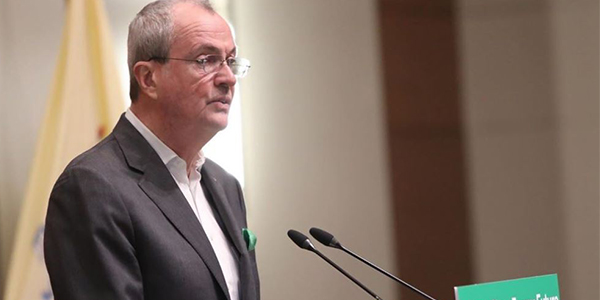By Rich Heidorn Jr.
New Jersey Gov. Phil Murphy on Monday released an updated Energy Master Plan outlining how the state will meet its goal of 100% “clean energy” and an 80% reduction in statewide greenhouse gas from 2006 levels by 2050.
“New Jersey faces an imminent threat from climate change, from rising seas that threaten our coastline to high asthma rates in some of our most vulnerable communities due to fossil fuel pollution,” Murphy said in a statement. “Successfully implementing the strategies outlined in the Energy Master Plan will drastically reduce New Jersey’s demand for fossil fuels, reduce our carbon emissions [and] greatly improve local air quality.”
Murphy also issued an executive order directing the Department of Environmental Protection to issue regulations to reduce emissions and adapt to climate change. The Protecting Against Climate Threats (PACT) regulations, due within two years, will require a monitoring-and-reporting program to identify all significant sources of GHG emissions and integrate climate change considerations, such as sea level rise, into the department’s land use permitting and other regulatory programs.
Murphy said the regulations will result in better planning and more resilient communities by avoiding construction in flood-prone areas, re-establishing wetlands, revegetating riparian areas and encouraging green infrastructure. “With this executive action, New Jersey is the first state in the nation to pursue such a comprehensive and aggressive suite of climate change regulations,” Murphy said.
The master plan, which was last updated in 2015, calls for:
- reducing energy consumption and emissions from transportation by encouraging electric vehicle adoption, electrifying transportation systems and using technology to reduce emissions and miles traveled.
- accelerating deployment of renewable energy and distributed energy resources with offshore wind, community solar, a new solar incentive program, solar thermal and energy storage. It includes low-cost financing for DERs.
- improving energy efficiency and conservation and reducing peak demand through new financing mechanisms and stronger building and energy codes and appliance standards. It will implement the state Clean Energy Act, which requires electric and gas utilities to reduce consumption by at least 2% and 0.75%, respectively.
- reducing energy consumption and emissions from buildings through decarbonization and electrification of new and existing buildings, the expansion of incentives to encourage net-zero-carbon homes and developing EV-ready and demand response-ready building codes.
- the creation of integrated distribution plans, investments in grid technology and a reduced reliance on natural gas.
- prioritizing clean transportation options in “underserved” communities and supporting the establishment of community energy plans.
- expanding New Jersey’s 52,000 clean energy jobs by making research and development investments to create services and products that can be exported to other regions.
The plan was embraced by numerous environmental groups, although some were disappointed that the definition of carbon-neutral “clean energy” includes nuclear power and natural gas plants that offset their emissions. New Jersey’s three remaining nuclear plants are set to receive subsidies of $300 million annually for the next three years.
At the New Jersey Board of Public Utilities’ meeting Wednesday, President Joseph Fiordaliso praised the governor’s plan but lamented that the state’s carbon-reduction efforts could become much more expensive as a result of PJM MOPR Rehearing Requests Pour into FERC.)



